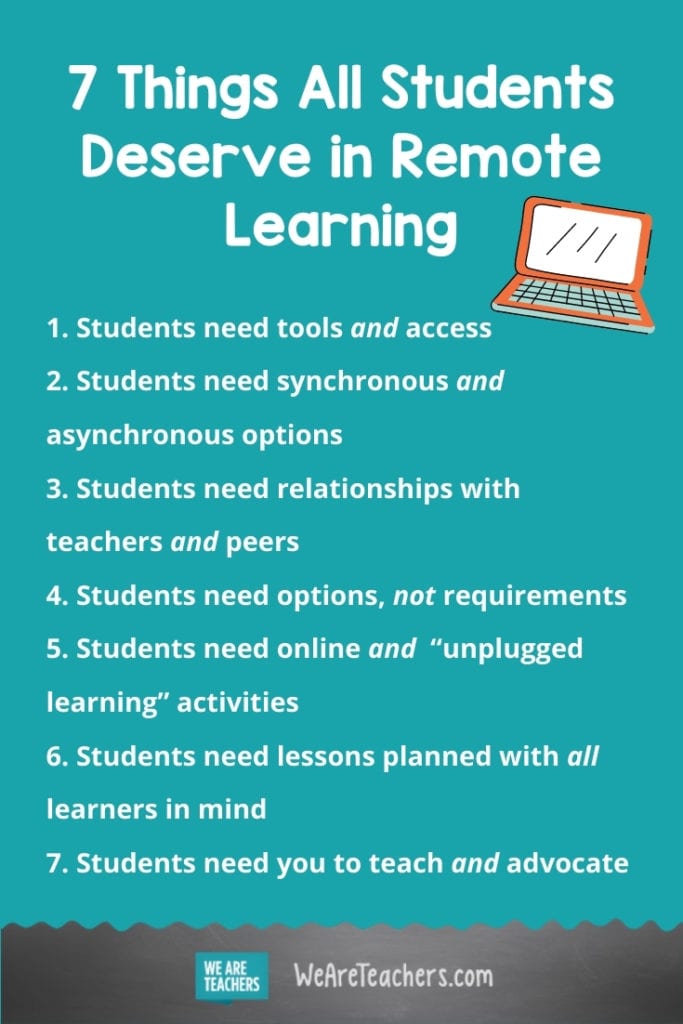There’s a lot that we can make work in remote learning. It’s been amazing to see how teachers have found all kinds of ways to teach their students across a screen. There’s also a lot that we can’t control. In person we can rest assured that our students have equal access to materials and resources. But it’s harder to give students an equal playing field when they’re learning at home. This is why making remote learning an experience that all students can take part in feels so important to figure out. So how do we know where to start? We looked to our teacher friends, and the experts at Houghton Mifflin Harcourt (who work with school districts across all 50 states), for 7 tips on building equity into remote learning.
1. Students need tools and access
First, we need to understand the distinction between equity (being fair) and equality (being equal) in education. Focusing on equality is helpful but won’t account for a community’s unique and specific needs. Providing every student with a computer is equal, but if students don’t have Wi-Fi at home, it’s not equitable. The bottom line: even with “equality,” some students will still experience challenges that make remote learning difficult. Students need tools (computers or tablets) and access (reliable internet). Consider issuing devices and hot spots. Another solution is to equip buses with Wi-Fi and park them in the community near students’ homes. We love what programs like W.O.W.(Wireless on Wheels) in Virginia are doing to increase internet access.
2. Students need synchronous and asynchronous options
For many communities, synchronous learning isn’t equitable if students can’t show up. Some students work to help support their families. Others don’t have consistent internet access. Lauren Occhipinti, a high school teacher in the Bronx, knows that many of her students have a tough time balancing school and home life right now. “Many of my students are now caretakers of younger siblings. It is very likely that students might miss my live instruction.” She provides more flexible deadlines and embeds links and videos into her asynchronous materials for students who need to go through the lesson on their own.
3. Students need relationships with teachers and peers
Distance makes relationships and meaningful connections more challenging. Our students are trying to learn in the midst of a global pandemic. If students don’t have access to their teachers and peers, they are less engaged. An equitable remote learning schedule prioritizes opportunities to check in and connect. While a live synchronous whole class meeting is an opportunity for students to connect, it isn’t equitable if all students can’t attend. Do your best to connect students when they can meet and have access. Leverage tools like Flipgrid if your students have equitable access to Wi-Fi so they can connect on their own time.
4. Students need options, not requirements
For many of our students, learning remotely introduces obstacles that are out of their control. When students are in school, they don’t have to worry about having a quiet place to work or needing to ask help from an adult. Students know they will be safe and fed. Because we are not in our students’ homes, we need to lower the stakes and prioritize their mental and physical health and well-being (Maslow’s Hierarchy of Needs is a powerful reminder). Make attendance optional for synchronous classes if you can. When you assign work, provide flexible deadlines (due Sunday) instead of due tomorrow. Host optional office hours at different times throughout the week, and encourage students to meet with you to check in and so you can teach, re-teach, and remediate.
5. Students need online and “unplugged learning” activities
Learning online doesn’t mean that students can’t or shouldn’t learn offline. You can increase equity in your approach to remote learning when you prioritize “unplugged” learning activities in addition to online activities. “Unplugged” learning doesn’t have to include a packet of worksheets. “Unplugged” activities like a scavenger hunt, a design thinking challenge, reading with a caregiver or a sibling, and writing a letter to a friend or relative allow all students to participate (no printer required). Parents and caregivers can post the list on the refrigerator and use them as weekend enrichment, extension activities, and brain breaks.
6. Students need lessons planned with all learners in mind
This year is the first year of a new way of teaching for all teachers and school leaders, whether you have been in the profession for ten days or a decade or two. We have to be open-minded and think strategically and thoughtfully about how to design online lessons that are accessible for all learnings. Dr. Amanda Patterson, National Director of Academic Planning and Analytics at HMH believes that we need to embrace experimentation. “I don’t have to always do what I’ve done because it is what I know,” she says. “I need to do something different. There will be some hiccups along the way. It’s ok.” Consider using UDL or the Universal Designing for Learning framework to create learning tasks with multiple means of engagement, representation, action, and expression.
7. Students need you to teach and advocate
Due to circumstances beyond our control, remote learning may feel as though it has been forced upon us. Rather than looking at this as a challenge we need to be optimistic and see all the opportunities for equity that lie before us. Dr. Patterson believes that an effective way to increase equity in remote learning is to be an advocate for your students and your community. “We need to view this crisis as an opportunity to level the playing field for all of our kids instead of a barrier.” No one will know your kids better than you and their caregivers. Learn what inequities there are and speak up. Use your role to address the inequities as much as possible. To learn more about how to increase equity in education, check out “5 Ways To Address The Equity Problem.”
What are your tips for increasing equity in remote learning? Share in the comments below.



